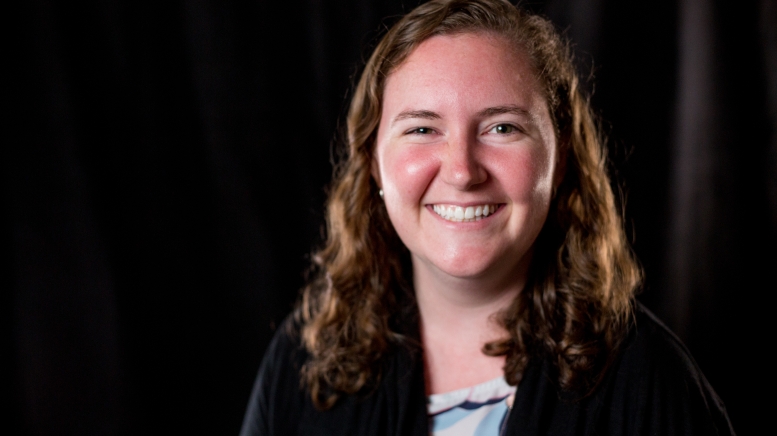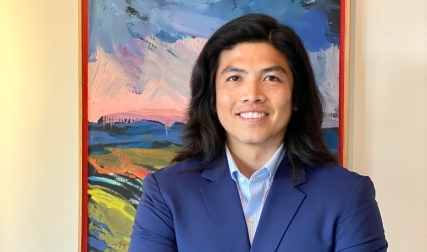If you watched Disney’s 2019 remake of Aladdin, you probably didn’t notice the way Iago’s feathers moved. Or maybe you saw The Irishman and wondered how Robert DeNiro, Joe Pesci, and Al Pacino traveled back in time to versions of their younger selves. Caitlin Hackett manages the artists and engineering projects responsible for these effects and details that transport viewers. With experience at top animation and special effects companies including DreamWorks, Industrial Light & Magic (the visual effects company George Lucas founded to develop effects for Star Wars), and now Pixar, the San Francisco-based math and sociology major found her path through Dartmouth’s digital arts minor. She spoke with DAM about the challenges of working with artists, how streaming has changed the effects industry, and her night at the Oscars.
Tell me about your current role at Pixar.
I’m working in production management, currently managing art and assets on a TV streaming project. “Art” meaning concept art—designing the world and the characters—and assets meaning basically everything from physically building in the 3-D world to the model of the character to rigging it so that it can move. There’s also hair grooming, building sets, and then shading everything so it looks pretty. I don’t have artistic talent myself, but my talent is being able to help the artists achieve their highest potential.
How does your work appear on screen?
Let’s use Toy Story as an example, since everyone’s seen it. Woody is a 3-D model. The art side of that would be drawing what he looks like on paper, which might mean 50 iterations. Once we finalize a design, it goes to modeling, which is where they’ll build the character in 3-D. Rigging it is like putting a skeleton on a 3-D model. Shading it is taking that gray mesh, or gray model, and painting it so that it looks like the Woody we know. From there, it’s handed down to the departments that pose it and light the scene and do more of the shot work.
What is the best part of your industry?
I think the best part of this whole industry is the people. They’re such fun, young-at-heart, creative people, and you’re close to Hollywood glamour without all of the downsides of Hollywood. And getting to see your small, small piece show up on a big screen is just so rewarding.
What’s the most challenging part?
There is this feeling that you missed the good old days. At ILM there was a lot of reminiscing like, “Oh, back when we were working on Jurassic Park….” It feels like the industry has expanded so much in both visual effects and innovation that it’s less about the artistry and more about mass producing. I think that’s a challenge, to try to retain that artistry while going faster and doing more of it.
Is that because of all the streaming platforms and the demand for more content?
Exactly. You work on a lot more projects instead of being able to really take your time on one thing.
What are some of the bigger projects you’ve been part of?
At ILM The Irishman was a movie I worked on for about four years. We developed a new facial capture technology to de-age the three main characters. [Director] Martin Scorsese wanted “markerless on-set” facial capture, which is really, really hard to do. Typically, the actors will have cameras mounted to their heads and dots on their faces. And they’ll be in a very controlled environment in order to capture the facial expressions that they’re making. The engineers that I worked with developed a way to do this [without facial markers]. The main advantage is that the actors can actually have a normal conversation versus having all of this gear impeding their process. It really unlocked a lot of good performances and left all the effects for us to deal with afterwards. I got to go to the Oscars for it because we were nominated [for best visual effects].
How was Oscars night?
It was really special that my lead for that project was nominated, because usually research and development and engineering don’t get to be in the spotlight. It felt like a celebration of the culmination of four years of really hard work. We didn’t win, but I got to meet Lin-Manuel Miranda, who was the one celebrity I felt I had to go up to and say hi. He was so nice.
How did you know this was the kind of work you wanted to do?
Until I started in this field, I didn’t realize how much I was destined for it. I always loved animation, but I never thought of it as a career, especially since I wasn’t particularly artistic. It was actually Dartmouth that opened the door for me. I thought I wanted to go into advertising and heard that I needed an art minor to do that. I started taking some art courses, and they just weren’t for me. But I found out about five minutes before the class began my junior spring term that I could take a digital modeling class that would apply to the art minor. The class was full, but I stayed and the professor let me in. It opened my eyes to this whole world that I didn’t even know was possible. The professor, Patricia Hannaway, had worked at Disney and DreamWorks, and I was just blown away by her. I completely changed gears and did a digital arts minor.
What’s your advice to anyone who wants to get started in the business?
The digital arts program at Dartmouth is great. Lorie Loeb, who runs it, is one of my mentors. The classes are fun and collaborative, and it’s such a good group of people. I’d say use the Dartmouth network—I got my job at DreamWorks from a Dartmouth connection who had been in the digital arts program a few years before me.
What are you working on next, and what are your other career aspirations?
Gosh, I wish I knew! I’m just excited to be learning as much as possible at Pixar in my current role and seeing where it takes me. I’ll be working on my show for a couple more years before I move onto a new project. Longer-term, I’m still not sure if I’m interested in the show producer track or a more department-focused track like I was on at ILM. As long as I continue to help creative people produce magic, I’ll be happy.


